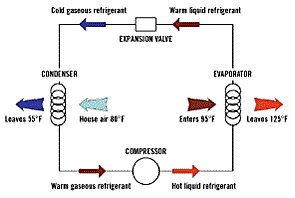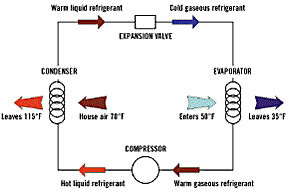Most people have delegated heat pumps to the residential-only category, so the first thing to do is to dispel that notion with some solid reasoning.

The technology
Heat pumps operate on the same refrigeration cycle used by any other conventional air conditioning system. The only difference is that the refrigerant loop is configured with reversing valves so the refrigerant cycle can go either way. It can take heat from a space and discharge it outside; or take heat from the outside and bring it inside.Like a fan that turns clockwise or counterclockwise depending on how it is turning when the motor starts, the refrigerant coils don't care whether they are in the evaporator or condenser mode. The system is just as efficient, and effective, either way. (See Figures 1 and 2.)
It is a popular conception that heat pumps are more complex than other systems. However, they have only two more moving parts than a conventional refrigeration unit, with zero-maintenance electric coils for heating.
Studies have shown that, when correctly designed, installed, and maintained, heat pump systems are just as dependable as any other heating-cooling system.

Applications
The only constraint on the heat pump is that efficiency drops when the outside temperature falls below 45°F, to the point where the system usually turns off below freezing and uses electric resistance coils for the heat source.Electric heating is, unfortunately, the most costly way to heat a space. It can only be justified in climates where the ambient temperature during regular building operating hours drops below freezing for only a few days each year.
That is not to say that heat pumps can be used only in temperate areas, because there are many buildings in northern regions that must run air conditioning all winter. These are typically large, multistory buildings with a large lighting or people load in interior spaces (those with no exterior exposure via walls, roof, or floor).
The only occupied spaces that require heating in the winter are the exterior zones. The rest of the building needs cooling all year. These areas can be easily served by a heat pump, perhaps with a warm-up cycle to keep frost from forming on the outside coils when it's cold outside. This cycle need operate only until the internal loads of the building begin to call for cooling.
Often the exterior zones of a building are served by dedicated air handlers anyway, and the interior zones are handled by other air handlers. Consequently, it is not mechanically impractical to install heat pumps for interior zones, and conventional systems with gas furnaces for exterior zones.
The benefits of using heat pumps for interior zones are simplicity, space, and cost. The systems are simple because there is no furnace. Reheat can be used just as it is for conventional systems, using vav boxes with coils.
Thus, dual-duct systems are not necessary, nor a mixing plenum as the case may be. This saves a lot of ceiling space, and floor space as well, because the footprint of the heat pump system is smaller - all of which contribute to lower cost.
Accessories
A popular and effective use for heat pumps in the summer and for wintertime cooling systems is to provide hot water.This requires only a simple modification to the basic system, to discharge the heat extracted from the building air to water in a tank, instead of the air. The heat transfer efficiency to water is almost twice as efficient as to air, so you not only get free hot water but a more efficient cooling process as well.
A clever installation can locate the heat pumps uniformly through a building, so no other primary hot water source is required.
The size and amount of hot water piping is drastically reduced with more local service, as is the pump size and operating cost because the hot water is always used relatively close to the source.
Finally, with hot water available from several sources in a large building, there is redundancy - which is always nice.
Hybrid systems
To this point the idea has been, in cold climates, to use conventional systems for exterior zones, and heat pumps for interior zones. However, owners don't like to mix equipment types because that complicates maintenance and upkeep. So consider the options for using heat pumps even for exterior zones with a high winter heating load.The simplest option would be to use a heat pump-gas furnace arrangement. The size of the furnace would be much smaller than for a conventional system, since the heat pump operates efficiently down to 45°. Still, it's not a common equipment combination, and so is probably not the best idea.
A better option is available for buildings with a large outside air load, such as schools. The outside air is usually treated at a single, central location in order to extract some energy from the exhausted air volume. A large gas furnace is the most energy-efficient solution in such a situation.
The rest of the building heating load from the envelope is often offset by the people and lighting in, say, the classrooms. So, once the building reaches operating temperature in the morning, there is no real need for further heat from the local air handlers; or, at least, a heat load they cannot handle efficiently (i.e., above 45°). This district wide warm-up cycle can often, in fact, be accomplished using the outside air system alone, with a higher discharge temperature.
For buildings with less of an internal heat source, an all heat pump system would have to depend on reheat coils in the
vav boxes, or electric heat if it can be justified cost wise over hot water coils.
Water-source systems
A final alternative for our hoped-for, all heat pump building is to provide water-source heat pumps for exterior zones.Water-source systems discharge/extract heat from water flowing in a closed fluid loop. If anything, they are simpler and more dependable than air-source systems, since they operate at a much more constant, and cooler, temperature.
Typically, a small boiler and cooling tower would be required to service a battery of exterior zone air handlers. However, in large buildings with water-source heat pumps throughout, a
carefully designed fluid system can deliver cold water from exterior zones to the interior zones, and vice versa, thus requiring an even smaller boiler and cooling tower.
Conclusion
This article has taken the idea of heat pump applications to the limit of using only heat pumps in a large commercial building.Although this may in fact be practical, the point was to offer ideas on the general use and versatility of heat pump systems.
Heat pumps are an efficient, dependable technology that deserve equal consideration with other heating and cooling systems. Used in combination with other systems, they can greatly enhance the efficiency of a heating and cooling system, at a lower installed cost.

Report Abusive Comment